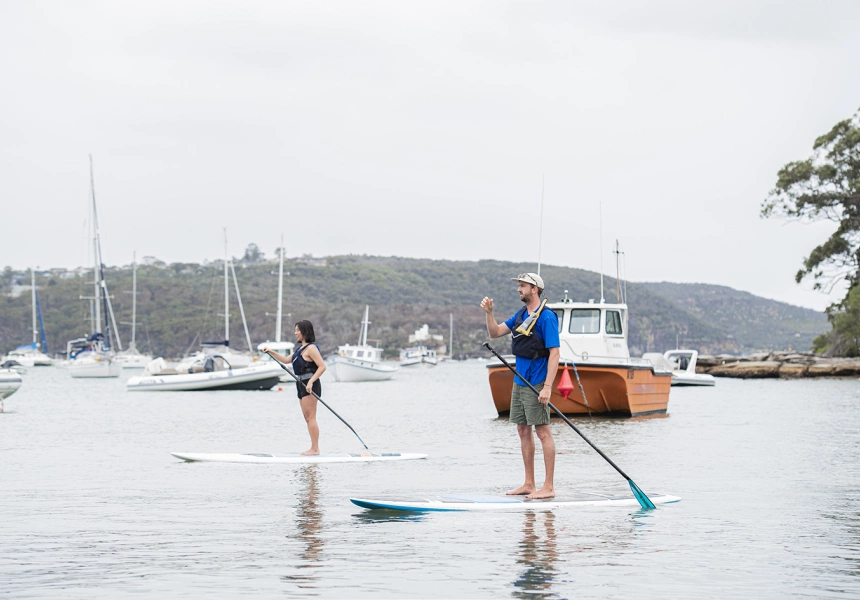Two months ago, I would’ve said stand-up paddleboarding (or SUP as people call it) wasn’t for me. I’d always associated the water sport with tanned, athletic figures, and I didn’t see myself that way. But, I was once a gymnast – maybe I’d have some underlying balancing skills I could tap into. Keen to find out if I could pick up the basics, I met with SUP instructor Sam Parker from Balmoral Paddlesurf school.
On the day, the weather was overcast, the air was damp with humidity, and there was a soft breeze creating speed bump-sized waves that broke gently on the shore. The first thing Parker did was to set me up with the right equipment: a life jacket (mandatory at most SUP schools), a board and, of course, a paddle.
The first thing I notice about the board is that it’s sturdier than I imagined. It’s three metres long and its foam or flotation volume could hold up to 195 litres of water. Parker says this is what gives the board its buoyancy, and for beginners this needs to be at least double your weight.
Never miss a moment. Make sure you're subscribed to our newsletter today.
SUBSCRIBE NOWHe passes me a paddle and explains its parts: the T-shaped handle at the top, the shaft and the blade, which is like a concave fin. As a general rule, the height of the paddle should reach the base of your hand when your arm is stretched up to the sky, while the blade needs to be angled so that it scoops the water, similar to spooning ice-cream from a tub.
I’m learning all this from the safety of the beach, which is where Parker runs through simple moves to do when on the water. He says it’s important to maintain a straight stroke line for steering, suggesting I switch my hand placements when alternating paddling from one side to the other. When paddling on the left, your right hand should grip the T-shaped handle, and your left hand should grip the shaft. For the right-hand side, you do the opposite.
I try to commit this to memory as we go through our strokes on land: a forward stroke – paddling from front to back; a backward stroke – paddling from back to front; and C-stroke – used for turning the board in the opposite direction.
Carrying the board under one arm, holding the paddle in another, we walk towards the water and stop once the water is at knee height. I stabilise the board with one hand, rest my paddle on top, push my body up to a kneeling position and look out to the horizon. So far, so good.
Preparing to stand, we paddle a little further into the bay. Parker reminds me to keep my knees slightly bent as I stand, with my feet equal distance from the middle of the board, around shoulder-width apart. Slowly but surely, I stand up. A little surprised, but also delighted, it feels like I’ve found my balance.
Looking out across the bay, I can see why people like this. It’s tranquil; the sounds of the nearby cafe are muted by the sloshing of the water and my focus is narrowed to the task at hand. Luckily, the water is calm and I only need a slight level of exertion to stay afloat. Chatting to Parker, he says his number one tip for beginners would be to check the weather before you go out. He says I’d be surprised by how many people start paddling out with the wind then find themselves working against the wind to paddle back to the shore. He relays a tale of rescuing a group that had drifted away with the wind, without the strength to come back.
Unfamiliar with nautical terms, how can a beginner tell if the conditions are good enough? Check the Bureau of Meteorology first, advises Parker. Go out in winds no more than 15 knots (or around 27 kmph). Better yet, get advice from your local SUP hire shop.
To test the power of the wind, we turn our backs to the shore and point our boards towards the ocean. We feel the wind pick up and in a matter of seconds we’ve covered metres without even paddling. As anticipated, the waves get choppier and I feel a bit wobblier. Before I know it, I’m back to the safety of paddling on my knees.
It turns out, contrary to the name stand-up paddleboarding, resting on your knees is quite acceptable. For me, it’s not only much easier but also more relaxing. I ask Parker if there are any rules to this. He shakes his head, smiles and says, “Paddleboarding is meant to be for fun. Paddleboarding is for everyone.”
Parker’s top tips for SUP beginners
- Book a lesson – you’ll pick up tips and confidence.
- Only go out on the water in light winds.
- Stay close to the shore and wear a buoyancy aid.
- Buy a SUP board from your local store, they will help with the size and weight you need.
- Buy a wetsuit if you want to go out in cooler weather. Cool rainy days are perfect for paddling.
- Have fun.
This article was originally published on December 10, 2021. It has been updated to reflect new information and remove out-of-date details.



